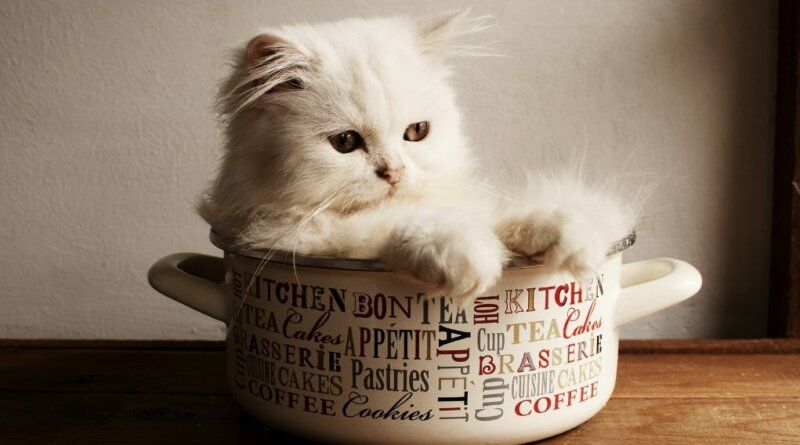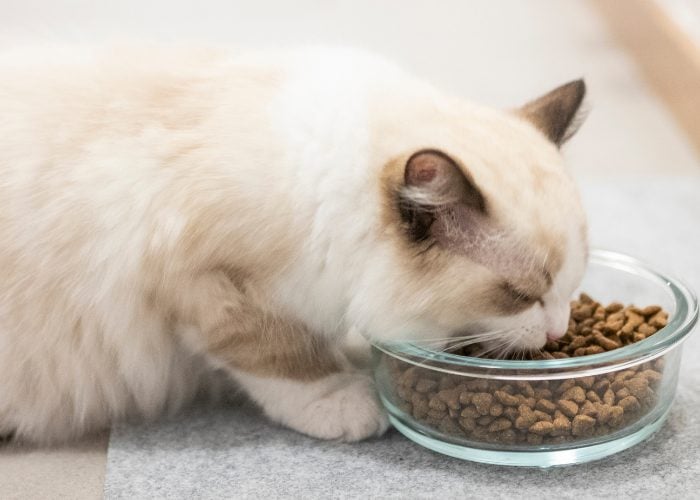An Overview – Top Dog Tips
Did you know that the Ragdoll is the most paw-pular cat breed of 2020? So if you want a fluffy companion who vibes along, the large and cuddly Ragdolls are for you.
This lovely breed is known for its mellow personality and gentle blue eyes. They’re notable for their temperament, described as docile and soft.
A Ragdoll’s nature makes it fit as an indoor and companion pet, but don’t let the large size intimidate you! More often, you’ll find this cat breed happy and warm in your arms for a wanted cuddle session.
This article will discuss all you need to know about Ragdoll cats, including their personality, physical features, and health.
Who knows—maybe this cat is the one you’re looking for all along?
Ragdoll Cats’ History
Ann Baker, an American cat breeder, created the Ragdoll cats around the 1960s. She wanted to make a cat with a loving personality that mirrors its beautiful appearance, thus, the birth of Ragdolls.
She eventually called this breed the Ragdolls and the cattery Raggedy Ann.
Presumably, the breed is a mix of Burmese, Birman, and Persian cats. However, a Turkish Angora named Josephine gave birth to the first Ragdoll litter.
One of the kittens named Daddy Warbucks is the founding father of the first generation of Ragdolls.
But according to records, the Ragdolls’ origin is still unknown. It’s because of Baker’s inconsistency with her stories.
A Ragdoll Appearance
A Ragdoll usually has a dazzling white coat and beady blue eyes. Besides, their dark markings are known to be their quirk too!
Overall, Ragdolls vary in different patterns and colors.
These are the four main Ragdoll Cat Patterns.
Ragdoll Cat Patterns
- Colorpoint – The classic type of Ragdoll pattern, where colors of the ends of their paws, tail, and ears are dark.
- Mitted – Similar to the Colorpoint, except that the ends of their paws, tail, and ears are in a lighter color.
- Bi-color – They have darker patches on the top of their head, especially the ears. Their noses are pink, the dark patches extend to the back, and they should be white all over.
- Van – This type of Ragdoll has an overall white coat except for a small dark patch located on their head, mask, and tail. Their paw paddings and noses should be a pink color.
On the other hand, Ragdolls have six distinct hues—red, seal brown, chocolate, lilac, blue, and cream. Let’s start with the solid point colors:
Solid Points
- Seal Point Ragdoll – Their coats are warm cream to dark in color and have a lighter shade by the areas of their abdomen.
- Blue Point Ragdoll – Their gray-blue coats are lighter on their center, but it gets darker up to their limbs, tail, and head.
- Red Point Ragdoll – Also known as flame point, their bodies are dull to bright white with reddish hues, like apricot, at their ends. Their paw pads and noses should always be pink.
- Chocolate Point Ragdoll – Their color ranges from cream to ivory, with brown points on their limbs, tail, and head.
- Lilac Point Ragdoll – They have a pure white body with gray undertones at their paws, ears, and other points. Their nose and paw pads are pink to lavender in color.
- Cream Point Ragdoll – They’re white all over with splotches of warm cream color on the mask of their face and points. Their nose and paw pads are pink, but the shade depends on the intensity of their color.
Below are their markings known as Tortie points.
Tortie Points
- Seal Tortie Point – They have cream to fawn-colored fur, with their seal-brown points marked with red or a mix of red and cream.
- Chocolate Tortie Point – They have ivory fur that will gradually darken as they grow older. Their points resemble milk chocolate colors with red or red-cream splotches.
There are also what we call the Lynx points:
Lynx Points
- Seal Lynx Point – They have rich, brown points overlaid with lighter Lynx stripes.
- Blue Lynx Point – They have most of their fur coats in white, with blue undertones striped on their points
- Red Lynx Point – Has overall white bodies with streaks of red undertones by their points and masks. Sometimes you could even see the stripes all over their bodies.
- Chocolate Lynx Point – Their bodies may be ivory, but their striped points are in a milk chocolate color.
- Cream Lynx Point – They have pale cream stripes on their points, but other than that, their coats are pure white.
- Lilac Lynx Point – They have pure white coats with gray undertone stripes on their points.
Cream points are also present:
Cream Points
- Blue Cream Point – Their white coats are on the colder side of color, with deep gray points.
- Lilac Cream Point – This is the same as Blue-Cream Point, except for pink undertones on their fur.
There is also a combination of the Lynx points and the Tortie points, known as Tortie-Lynx points.
Tortie-Lynx Points
- Seal Tortie-Lynx Point – Their points have a striped dark brown undertone and have pale to cream fur. They also have undertones of red and pink.
- Chocolate Tortie-Lynx Point – They have ivory bodies with milk chocolate points. Their noses and paw pads may vary in shades of pink.
Lastly, the Cream and Lynx points combination is also known as the Cream Lynx point.
Cream Lynx Points
- Lilac Cream Lynx Point – Has platinum to blue-white fur all around their bodies and pink color on their noses and pads. Overlaid in their coat is a range of colors, from red and cream.
- Blue Cream Lynx Point – Same as the Lilac Cream, except that their points are in shades of grayish-blue.
In addition, Ragdolls have medium-length hair with a soft and silky texture that they can easily compare to a rabbit’s fur.
Due to their coat’s distinct features, you must groom them regularly to keep their condition.
Unlike other cat breeds, this breed does not have an undercoat, which lessens the reactions of people who have allergies. But this does not mean that they are hypoallergenic.
Some breeders often market them as hypoallergenic, but this isn’t entirely true. It isn’t by their coat that allergic reactions are imminent, but it’s their saliva and secretions that trigger allergies.
A Ragdoll Temperament
As mentioned earlier, Ragdolls are notorious for being extremely affectionate and cuddly. If you plan to own one, expect them to slip and snuggle with you every chance they get.
They are also charming, pleasant, and softhearted. Ragdolls are cuddle bugs whose loyalty may be similar to a dog’s.
However, Ragdoll cats may become aggressive once they reach sexual maturity around three years old. It’s because of the hormones that their bodies produce, which make them frenzy.
Furthermore, this breed doesn’t care if you have a big or a small family because they’re surprisingly pleasant and friendly. You do not have to worry a lot about how to mingle with them.
How to Train a Ragdoll
Ragdolls are naturally playful and trainable. They are more disciplined and intelligent than other cat breeds.
However, they do not trust other people quickly when it comes to training. You have to earn the trust of your cat before you proceed with training them.
As kittens, they are lively and energetic, so you must start training them around a young age. Because when they’re older, they would rather spend their time sleeping than move around.
With their adaptability to most environments, these felines can be energetic and playful.
With the proper training, you can even teach your Ragdoll cat how to fetch!
Using Positive Reinforcement and Rewards System
An excellent way to start training them is to introduce them to several methods to kindle their interest.
Enticing them with stuff that they like is one thing, but encouraging them is another.
Ragdolls do not do well with pressure and harsh responses. Thus, you have to make sure that you are handling them with care.
Positive reinforcement training uses rewards (e.g., food or toys) to encourage a cat’s desired behavior. It also includes giving treats such as petting or grooming.
The Use of Clicker Training
A clicker is a user-friendly tool that can help you introduce your cats to specific signals when training. In essence, this device produces clicking sounds which will serve as a stimulant to your pet.
Clicker training is beneficial because it is an unspoken affirmation that they’re doing great at succeeding in their training. One way to use it is to discipline your naughty pet.
If they’re misbehaving, try not to give them any treats. However, if they’re not, associate their rewards with clicking sounds.
But if they are behaving, even if you’d know they’d get excited at anything like food, click to say they’re doing great.
However, bear in mind to always click the tool short and not overuse it to avoid what we call extinction or the absence of response to the stimulus.
Avoid Punishment and Pressure
In general, cats do not sit well with punishments. With that in mind, it’d be best to avoid situations that will cause them discomfort and create unpleasant associations.
Never, in any way, pressure your cat to perform well—at least observe baby steps while teaching them. They can quickly pick up what you’re trying to tell them, but being harsh won’t give you the results you want.
How to Groom a Ragdoll
Grooming sessions are a luxury for Ragdolls. Compared to other cats, they tend to enjoy it because of the special care and attention.
If you’re planning to have a Ragdoll, you must start grooming them regularly as kittens to avoid mishaps when they grow older. Luckily, their fur does not clump and mat easily, but it may happen anytime with improper care.
As mentioned earlier, these cats do not have an undercoat. Thus, you must avoid grooming them with hard-wired and pinned bristled brushes.
In addition, bathing is not necessary for this breed, especially if they always keep their coat clean. However, when grooming a Ragdoll, you must always check for signs of lumps on their skin before brushing.
You can also clean your Ragdoll’s ears by dropping a feline ear cleaner on their ears before gently massaging them. Besides, clipping their claws short is essential to prevent them from hurting themselves.
Shedding is a common thing for Ragdolls, especially during warmer seasons.
A Ragdoll Diet
Ragdolls are natural carnivores; thus, their diet must consist of meats and proteins. However, you must not forget to give them wet food to prevent them from having excretory problems.
Introduce vitamins to your cat by adding small amounts to their food. Make sure not to add a lot because they might recognize and avoid it.
Cats are nitpicky with whatever they eat, and Ragdolls are no exception.
A favorite Ragdoll treat is a steamed white fish. They also like unsalted canned fish and raw minced beef.
Avoid leaving out food to prevent them from overeating; otherwise, they might suffer from a case of diabetes or obesity.
Try working with your vet to create a balanced diet appropriate for your cat’s age and energy exerted daily.
A Ragdoll Health
Ragdolls’ common health problems include bladder stones and hypertrophic cardiomyopathy.
To avoid bladder stones, encourage them to drink lots of water while feeding them at the same time with high-quality food.
In contrast, Hypertrophic cardiomyopathy is worse due to its genetic nature. Check your cats with your local vet if you must!
As large breed cats, Ragdolls also suffer from weight issues associated with their sizes, such as obesity or diabetes.
While fluffy fat cats may be cute, that does not mean they’re healthy. Help them maintain their normal average weight by monitoring their diet.
On the other hand, Ragdolls usually mature by the age of four. Their estimated lifespan is at least thirteen to fifteen years and could stretch for more.
Conclusion
Ragdolls are a special breed of companion cats.
If you plan to adopt a Ragdoll, look for a trustworthy breeder who takes care of healthy and energetic litters.
Furthermore, determine your finances, budgeting, lifestyle, and time management to see if you could get a ragdoll. Providing high-quality food, regular health trips, grooming, supplements, and other necessities should be equated to know if it’s affordable and budgeted.
Ragdolls have longer life spans compared to other cats. Consider your long-term situation for the next 15 years before you plan on adopting them.
If taken care of properly, expect your Ragdoll to be around for a longer time.
READ NEXT: The Costs of Cat Ownership










